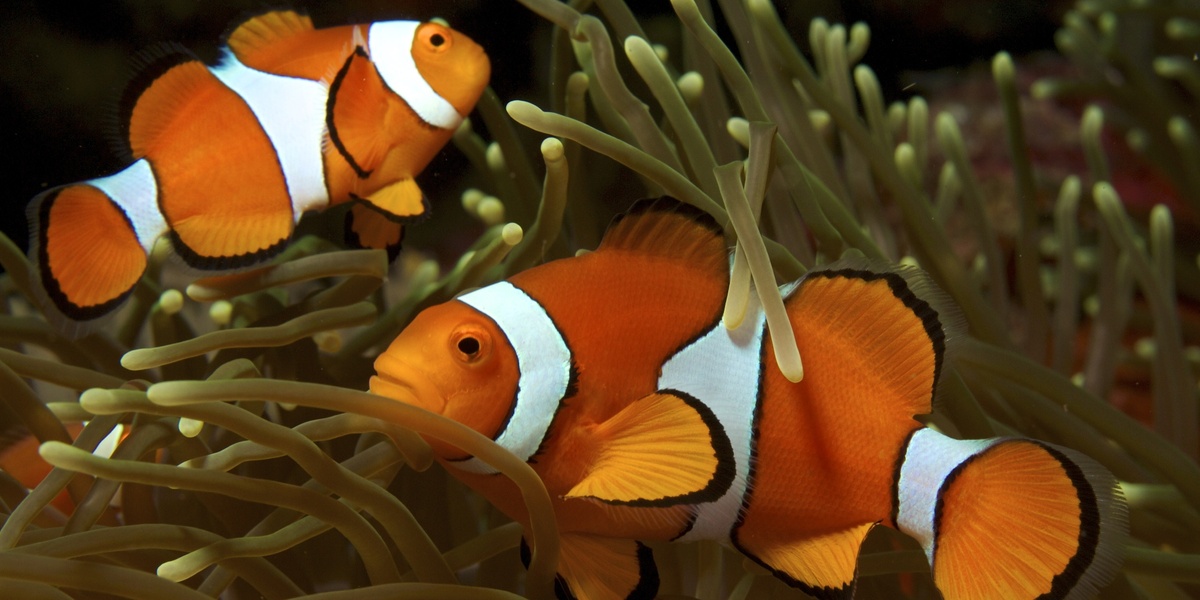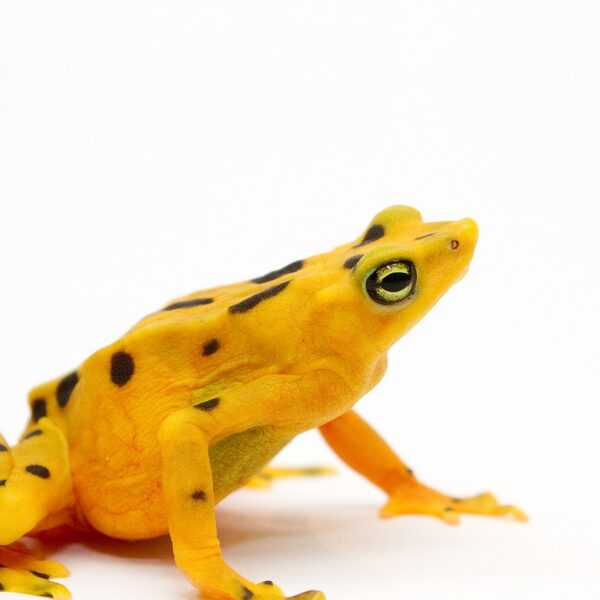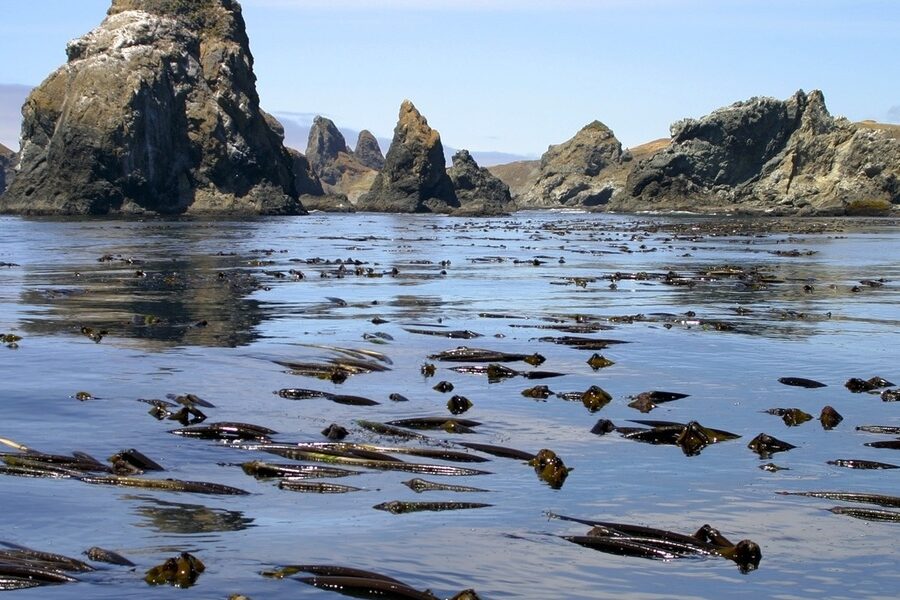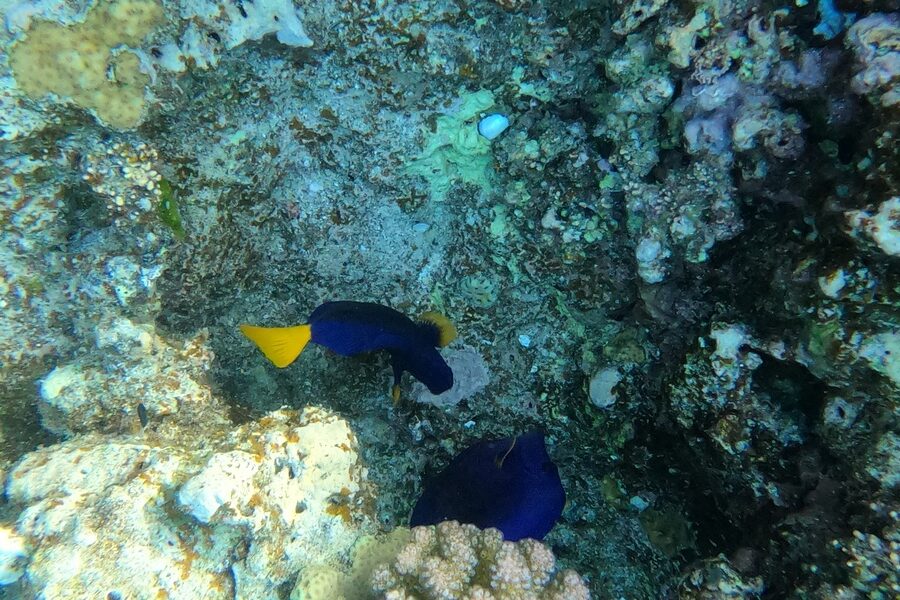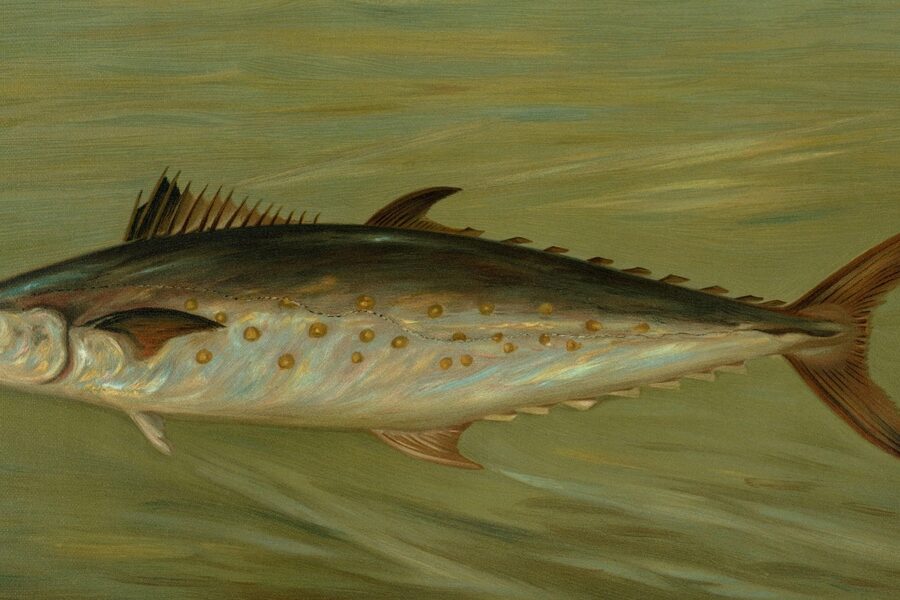Warm tropical seas and coral reef edges teem with life, from tiny cryptic invertebrates hiding under rocks to fast-swimming predators cruising open water. Whether you’re snorkeling a lagoon or scanning a reef slope, the variety in form and behavior across these habitats is what makes tropical marine life so interesting.
There are tropical ocean animals numbering exactly 90, ranging from Arrow Crab to Yellowfin Tuna. For each entry you’ll find below the columns: Scientific name,Size (cm),Habitat/region — a simple layout to help you compare species and spot patterns as you scroll; you’ll find below.
Are all these species found throughout the tropics?
No — many species on the list are region-specific. Some occur across multiple ocean basins, while others are limited to particular reef systems or coastal areas; check the Habitat/region column to see where each species is recorded.
How can I use the Scientific name,Size (cm),Habitat/region information for ID or study?
Use the scientific name for precise identification, size to rule out age classes or look-alikes, and habitat/region to narrow possibilities by location; combine those fields with photos or local guides for reliable identification.
Tropical Ocean Animals
| Name | Scientific name | Size (cm) | Habitat/region |
|---|---|---|---|
| Clownfish | Amphiprion ocellaris | 11 | Indo-Pacific, sheltered reefs within sea anemones |
| Emperor Angelfish | Pomacanthus imperator | 40 | Indo-Pacific and Red Sea coral reefs |
| Blue Tang | Paracanthurus hepatus | 30 | Indo-Pacific coral reefs |
| Yellow Tang | Zebrasoma flavescens | 20 | Pacific Ocean, especially Hawaii, on coral reefs |
| Parrotfish | Scarus iseri | 28 | Caribbean, tropical Atlantic, coral reefs |
| Humphead Wrasse | Cheilinus undulatus | 230 | Indo-Pacific coral reefs |
| Lionfish | Pterois volitans | 38 | Indo-Pacific native; invasive in Atlantic/Caribbean |
| Clown Triggerfish | Balistoides conspicillum | 50 | Indo-Pacific coral reefs with clear water |
| Porcupinefish | Diodon hystrix | 90 | Worldwide tropical marine waters, reefs, and open ocean |
| Giant Moray Eel | Gymnothorax javanicus | 300 | Indo-Pacific and Red Sea, coral reef crevices |
| Whale Shark | Rhincodon typus | 1,200 | All tropical and warm-temperate oceans, pelagic |
| Giant Manta Ray | Mobula birostris | 700 | Worldwide tropical and subtropical waters, pelagic and coastal |
| Spotted Eagle Ray | Aetobatus narinari | 500 | Worldwide tropical oceans, often near coral reefs |
| Blacktip Reef Shark | Carcharhinus melanopterus | 160 | Indo-Pacific and Mediterranean Sea, shallow reefs |
| Great Hammerhead Shark | Sphyrna mokarran | 600 | Worldwide tropical and warm-temperate waters |
| Green Sea Turtle | Chelonia mydas | 150 | Worldwide tropical and subtropical oceans |
| Hawksbill Sea Turtle | Eretmochelys imbricata | 90 | Worldwide tropical oceans, primarily coral reefs |
| Spinner Dolphin | Stenella longirostris | 200 | Worldwide tropical and subtropical oceans, pelagic |
| Dugong | Dugong dugon | 300 | Indo-Pacific coastal waters with seagrass beds |
| Giant Clam | Tridacna gigas | 120 | Indo-Pacific, shallow coral reefs |
| Flamboyant Cuttlefish | Metasepia pfefferi | 8 | Indo-Pacific, shallow sandy seafloors |
| Caribbean Reef Squid | Sepioteuthis sepioidea | 20 | Caribbean and Florida, shallow reefs and seagrass beds |
| Blue-ringed Octopus | Hapalochlaena lunulata | 12 | Indo-Pacific, tide pools and shallow reefs |
| Peacock Mantis Shrimp | Odontodactylus scyllarus | 18 | Indo-Pacific, coral reef burrows |
| Spiny Lobster | Panulirus argus | 60 | Atlantic, Caribbean, and Gulf of Mexico reefs and mangroves |
| Cleaner Shrimp | Lysmata amboinensis | 6 | Indo-Pacific and Red Sea coral reefs |
| Crown-of-thorns Starfish | Acanthaster planci | 40 | Indo-Pacific coral reefs |
| Blue Sea Star | Linckia laevigata | 30 | Indo-Pacific, shallow coral reefs and sand flats |
| Staghorn Coral | Acropora cervicornis | 200 | Caribbean, Florida, Bahamas, on shallow reefs |
| Brain Coral | Diploria labyrinthiformis | 200 | Caribbean and tropical Atlantic, coral reefs |
| Box Jellyfish | Chironex fleckeri | 300 (tentacle length) | Coastal waters of northern Australia and Indo-Pacific |
| Portuguese Man o’ War | Physalia physalis | 30 | Tropical and subtropical Atlantic, Indian, and Pacific oceans |
| Mahi-mahi | Coryphaena hippurus | 150 | Worldwide tropical and subtropical waters, pelagic |
| Great Barracuda | Sphyraena barracuda | 150 | Worldwide tropical and subtropical oceans, near reefs |
| Giant Trevally | Caranx ignobilis | 170 | Indo-Pacific, from reefs to offshore atolls |
| Yellowfin Tuna | Thunnus albacares | 240 | Worldwide tropical and subtropical oceans, pelagic |
| Sailfish | Istiophorus platypterus | 300 | Worldwide tropical and subtropical waters, pelagic |
| Moorish Idol | Zanclus cornutus | 23 | Indo-Pacific coral reefs |
| Copperband Butterflyfish | Chelmon rostratus | 20 | Indo-Pacific and Red Sea coral reefs |
| Long-spined Sea Urchin | Diadema antillarum | 50 (spine length) | Caribbean and tropical Atlantic reefs |
| Titan Triggerfish | Balistoides viridescens | 75 | Indo-Pacific coral reefs |
| Humpback Whale | Megaptera novaeangliae | 1,600 | Worldwide oceans, migrates to tropics for breeding |
| Saltwater Crocodile | Crocodylus porosus | 600 | Indo-Pacific, coastal mangroves, estuaries, and open ocean |
| Yellow-bellied Sea Snake | Hydrophis platurus | 90 | Tropical Pacific and Indian oceans, pelagic |
| Christmas Tree Worm | Spirobranchus giganteus | 4 | Worldwide tropical reefs, embedded in coral heads |
| Nudibranch | Chromodoris quadricolor | 4 | Indo-Pacific and Red Sea, coral reefs |
| Queen Conch | Aliger gigas | 35 | Caribbean, shallow seagrass beds and sand flats |
| Feather Star | Himerometra robustipinna | 20 | Indo-Pacific, coral reefs |
| Mushroom Coral | Fungia scutaria | 18 | Indo-Pacific, shallow reef slopes and lagoons |
| Goliath Grouper | Epinephelus itajara | 250 | Atlantic Ocean, from Florida to Brazil, artificial and natural reefs |
| Spanish Dancer | Hexabranchus sanguineus | 60 | Indo-Pacific and Red Sea, coral reefs |
| Chambered Nautilus | Nautilus pompilius | 20 | Indo-Pacific, deep reef slopes |
| Finger Coral | Porites porites | 100 (colony) | Caribbean and tropical Atlantic, shallow reefs |
| Sea Cucumber | Holothuria scabra | 40 | Indo-Pacific, sandy and muddy bottoms |
| Hawaiian Monk Seal | Neomonachus schauinslandi | 230 | Hawaiian Islands, sandy beaches and coastal waters |
| Arrow Crab | Stenorhynchus seticornis | 6 | Caribbean and tropical Atlantic, on reefs and wrecks |
| Flame Scallop | Ctenoides scaber | 8 | Caribbean, in reef crevices and under ledges |
| Harlequin Shrimp | Hymenocera picta | 5 | Indo-Pacific, coral reefs |
| Ribbon Eel | Rhinomuraena quaesita | 130 | Indo-Pacific, coral reef crevices and burrows |
| Banded Sea Krait | Laticauda colubrina | 100 | Indo-Pacific, coastal waters and coral reefs |
| Pygmy Seahorse | Hippocampus bargibanti | 2 | Indo-Pacific, on Muricella gorgonian corals |
| Flying Fish | Exocoetidae family | 45 | Worldwide tropical and subtropical oceans, surface waters |
| Leafy Seadragon | Phycodurus eques | 35 | Southern Australia (subtropical fringe), kelp forests |
| Horn Shark | Heterodontus francisci | 120 | Eastern Pacific (California to Mexico), subtropical rocky reefs |
| Fiddler Crab | Uca spp. | 5 | Worldwide tropical/subtropical coasts, mangroves, and mudflats |
| Lettuce Sea Slug | Elysia crispata | 7 | Caribbean, shallow reefs and seagrass beds |
| Nassau Grouper | Epinephelus striatus | 100 | Caribbean and tropical Atlantic, coral reefs |
| Reef Manta Ray | Mobula alfredi | 550 | Indo-Pacific, coastal and reef-associated waters |
| Scalloped Hammerhead Shark | Sphyrna lewini | 400 | Worldwide tropical and warm-temperate waters |
| Leatherback Sea Turtle | Dermochelys coriacea | 220 | Worldwide oceans, nests on tropical beaches |
| Olive Ridley Sea Turtle | Lepidochelys olivacea | 70 | Tropical regions of the Pacific, Indian, and Atlantic oceans |
| Flatback Sea Turtle | Natator depressus | 90 | Coastal waters of Australia (tropical/subtropical) |
| Ornate Ghost Pipefish | Solenostomus paradoxus | 12 | Indo-Pacific, near reefs and rubble |
| Frogfish | Antennarius maculatus | 15 | Indo-Pacific, coral reefs and rubble fields |
| Mimic Octopus | Thaumoctopus mimicus | 60 | Indo-Pacific, muddy seabeds |
| Wahoo | Acanthocybium solandri | 250 | Worldwide tropical and subtropical seas, pelagic |
| Spotted Moray Eel | Gymnothorax moringa | 120 | Tropical Atlantic Ocean, reefs and rocky shores |
| Gorgonian Coral | Gorgonia ventalina | 150 | Caribbean and tropical Atlantic, reefs |
| Moon Jellyfish | Aurelia aurita | 40 | Worldwide oceans, common in tropical coastal waters |
| Thorny Seahorse | Hippocampus histrix | 17 | Indo-Pacific, reefs and seagrass beds |
| Harlequin Filefish | Oxymonacanthus longirostris | 12 | Indo-Pacific, exclusively on Acropora coral |
| Longnose Hawkfish | Oxycirrhites typus | 13 | Indo-Pacific and Eastern Pacific, on gorgonians and black corals |
| Bobbit Worm | Eunice aphroditois | 300 | Indo-Pacific and Atlantic, sandy and muddy seabeds |
| Banded Coral Shrimp | Stenopus hispidus | 6 | Worldwide tropical oceans, on coral reefs |
| Slipper Lobster | Scyllarides aequinoctialis | 30 | Tropical Atlantic, coral and rocky reefs |
| Electric Ray | Torpedo marmorata | 60 | Atlantic and Mediterranean, sandy bottoms |
| Tiger Shark | Galeocerdo cuvier | 500 | Worldwide tropical and temperate waters, coastal and pelagic |
| Bull Shark | Carcharhinus leucas | 350 | Worldwide tropical and subtropical coasts, can enter freshwater |
| Sandbar Shark | Carcharhinus plumbeus | 250 | Worldwide tropical and temperate waters, coastal habitats |
| Bonefish | Albula vulpes | 90 | Worldwide tropical and subtropical shallow flats |
Images and Descriptions
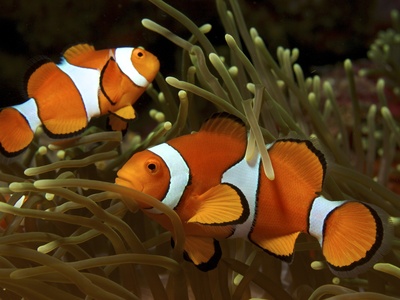
Clownfish
Bright orange with three white bars, this fish is famous for its symbiotic relationship with venomous sea anemones. The clownfish is immune to the anemone’s stings, gaining protection from predators while cleaning and feeding its host.
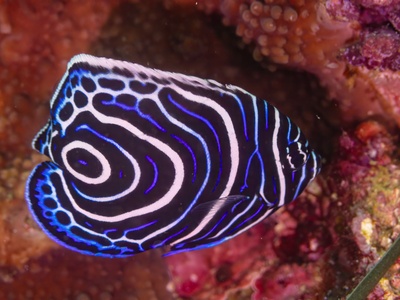
Emperor Angelfish
Juveniles are dark blue with electric blue and white rings, transforming into adults with bold yellow and blue stripes and a black “mask”. They are shy but stunning inhabitants of coral-rich areas, often seen grazing on sponges.
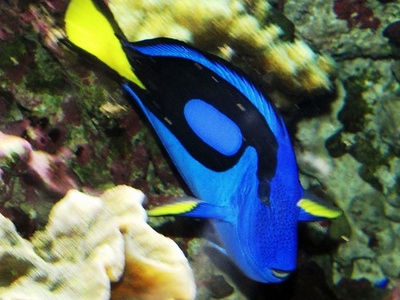
Blue Tang
A vibrant blue, oval-shaped fish with a yellow tail, made famous by popular culture. It possesses a sharp, venomous spine at the base of its tail for defense. They are crucial for reef health as they eat algae.
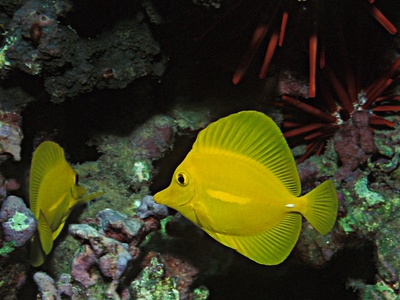
Yellow Tang
A brilliantly colored, disc-shaped fish that is a popular aquarium species. In the wild, they graze on algae in large groups, playing a vital role in keeping coral reefs clean and healthy, allowing corals to thrive.
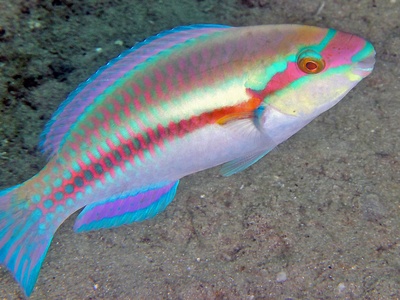
Parrotfish
Known for their beak-like teeth used to scrape algae off coral. They excrete the indigestible coral as sand, creating many of the world’s beautiful white sand beaches. Their vibrant colors change dramatically as they age.
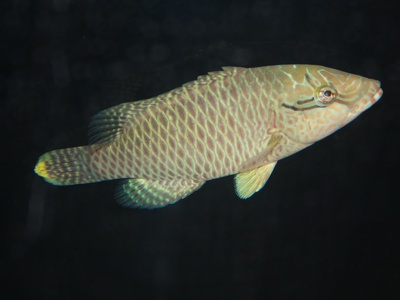
Humphead Wrasse
A massive, intelligent reef fish with a prominent hump on its head and fleshy lips. It can live for over 30 years and plays a key role in controlling populations of crown-of-thorns starfish, which prey on coral.
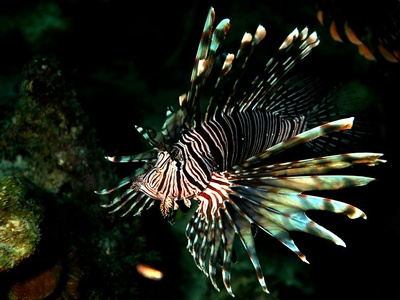
Lionfish
With dramatic, venomous spines and bold stripes, the lionfish is a striking predator. It is an invasive species in the Atlantic, where its voracious appetite and lack of natural predators disrupt local reef ecosystems.
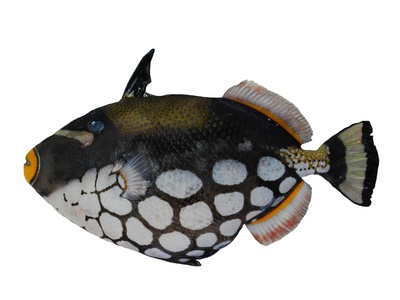
Clown Triggerfish
One of the most spectacular reef fish, with a black body covered in large white spots and a yellow-reticulated face. They use their strong jaws to crush the shells of crabs, sea urchins, and other hard-bodied prey.
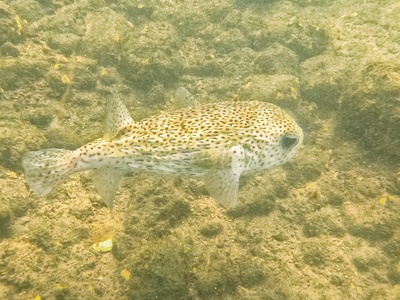
Porcupinefish
This pufferfish relative can inflate its body with water, causing long, sharp spines to stand erect as a defense mechanism. It has a powerful beak-like mouth used to crush the shells of mollusks and crustaceans.
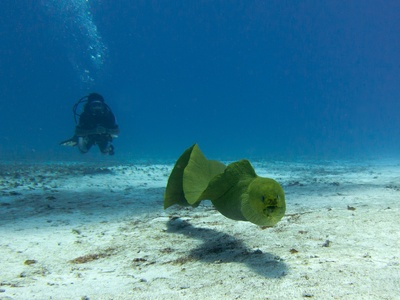
Giant Moray Eel
The largest moray eel by mass, this formidable predator lurks in reef crevices, waiting to ambush fish and crustaceans. Despite its menacing appearance, it is generally not aggressive unless provoked.
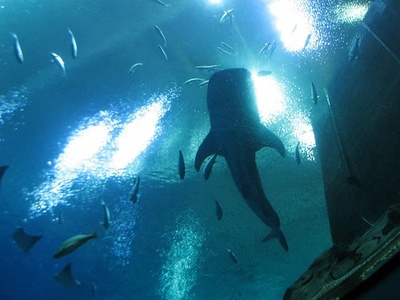
Whale Shark
The world’s largest fish, this gentle giant is a filter-feeder, consuming plankton and small fish. Its back is covered in a unique pattern of pale spots and stripes, which act as camouflage and are used for identification.
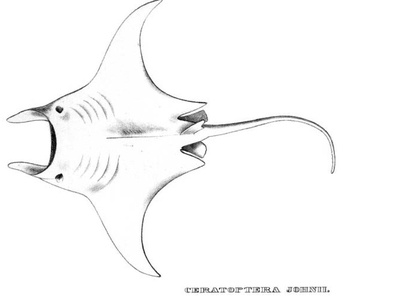
Giant Manta Ray
The largest ray in the world, recognizable by its huge triangular pectoral fins and cephalic lobes. These intelligent filter-feeders are often seen at cleaning stations on coral reefs or cruising in the open ocean.
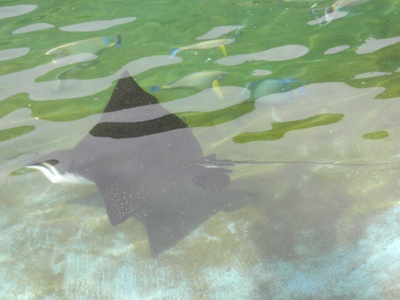
Spotted Eagle Ray
An elegant ray with a dark dorsal surface covered in white spots. It uses its flattened, plate-like teeth to crush clams, oysters, and crabs, and is known for its incredible ability to leap out of the water.
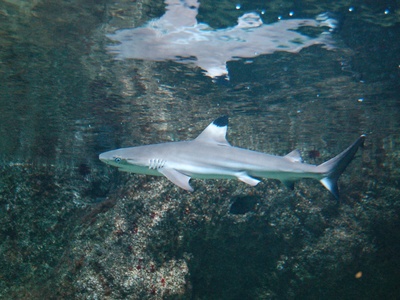
Blacktip Reef Shark
A common, relatively small shark easily identified by the prominent black tips on its fins, especially the dorsal fin. They are timid sharks that patrol shallow reef flats in search of small fish and crustaceans.
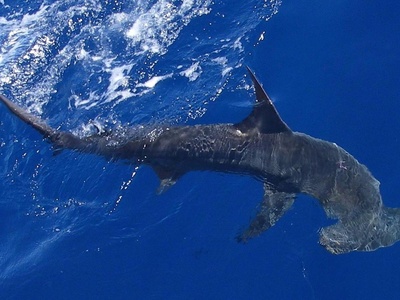
Great Hammerhead Shark
The largest of the hammerhead species, its uniquely shaped “hammer” head provides 360-degree vision and enhances sensory reception. It is a powerful, solitary predator that feeds on rays, crabs, and other fish.
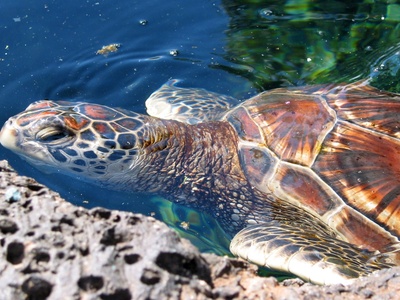
Green Sea Turtle
Named for the green color of its body fat, this large turtle is primarily herbivorous as an adult, feeding on seagrass. They migrate long distances between feeding grounds and the beaches where they were born to nest.
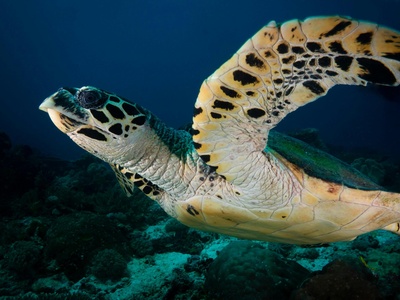
Hawksbill Sea Turtle
Distinguished by its narrow, pointed beak, this critically endangered turtle feeds mainly on sponges. Its beautifully patterned shell has unfortunately made it a target for the illegal tortoiseshell trade.
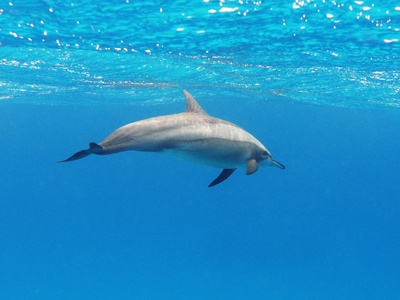
Spinner Dolphin
Famous for its acrobatic displays, this dolphin leaps from the water and spins along its longitudinal axis. They travel in large pods and feed on small fish and squid in deep offshore waters, typically at night.
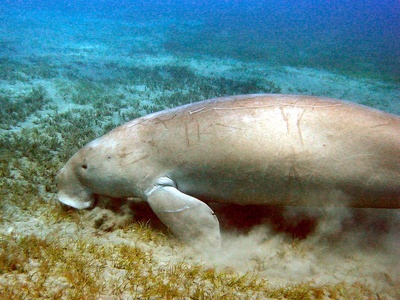
Dugong
A large, herbivorous marine mammal, often called a “sea cow.” Closely related to manatees, it feeds exclusively on seagrass in shallow, protected coastal areas. Dugongs are vulnerable to habitat loss and human activities.
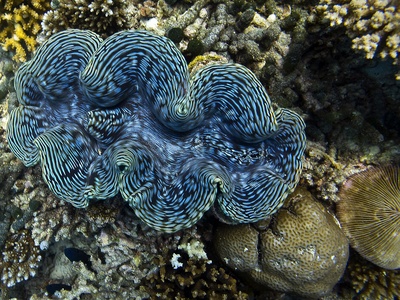
Giant Clam
The largest living bivalve mollusk on Earth, weighing over 200 kg. It hosts symbiotic algae within its tissues, which provide most of its nutrition through photosynthesis, creating its vibrant colors.
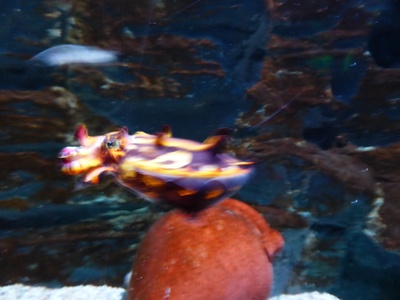
Flamboyant Cuttlefish
A small, dazzling cuttlefish that “walks” along the seafloor. It can rapidly change its skin color into spectacular patterns of yellow, black, and white, both for camouflage and to warn predators of its toxic flesh.

Caribbean Reef Squid
A social and intelligent squid often seen in small groups. They are masters of camouflage, capable of changing their skin color and texture in an instant to communicate or blend in with their surroundings.
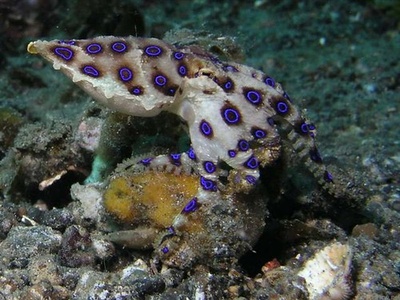
Blue-ringed Octopus
Small but deadly, this octopus flashes iridescent blue rings when threatened. Its bite contains a powerful neurotoxin, tetrodotoxin, for which there is no antivenom, making it one of the world’s most venomous marine animals.
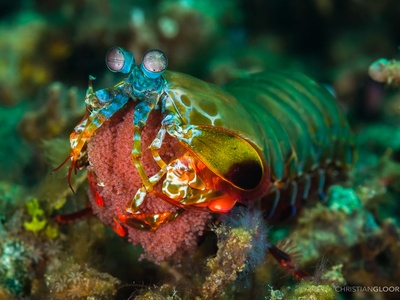
Peacock Mantis Shrimp
A vividly colored crustacean with one of the most complex visual systems in the animal kingdom. It possesses powerful “clubs” that can smash prey with the speed of a .22 caliber bullet, creating cavitation bubbles.
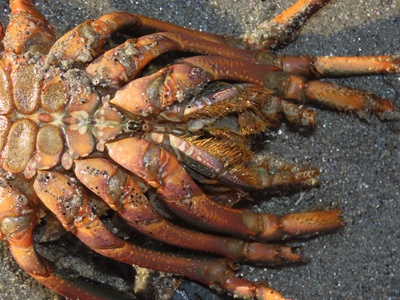
Spiny Lobster
Unlike other lobsters, the spiny lobster lacks large claws, relying on thorny spines on its body for defense. They are social animals that migrate in long, single-file lines across the seafloor.
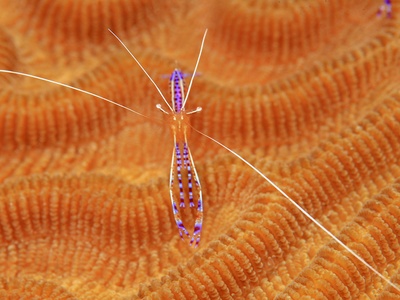
Cleaner Shrimp
This small, brightly colored shrimp operates “cleaning stations” on coral reefs. Fish, eels, and turtles visit to have parasites and dead tissue removed by the shrimp in a classic example of mutualism.
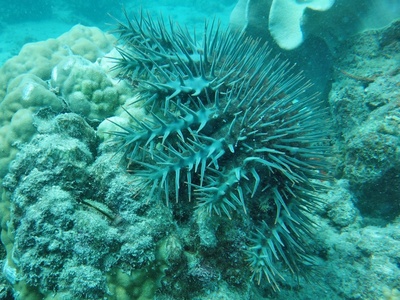
Crown-of-thorns Starfish
A large, venomous starfish covered in sharp spines that preys on coral polyps. Population outbreaks of this species can cause widespread devastation to coral reefs, consuming vast areas of living coral.
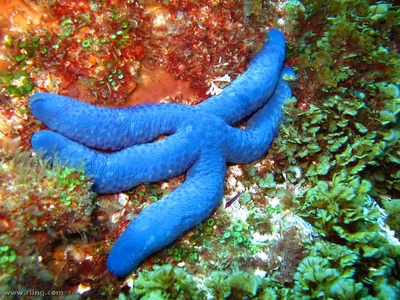
Blue Sea Star
A brightly colored starfish that is a common sight on tropical reefs. It primarily feeds on detritus and algae. It has remarkable regenerative abilities and can regrow an entire body from a single severed arm.
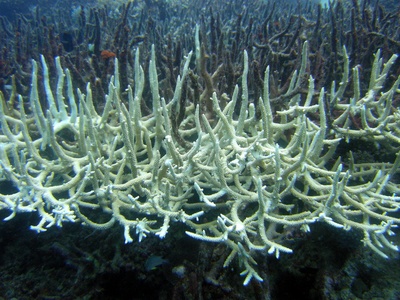
Staghorn Coral
A critically endangered, branching coral that provides essential habitat for thousands of reef species. Its fast growth rate once made it a dominant reef-builder, but it is highly vulnerable to disease and climate change.
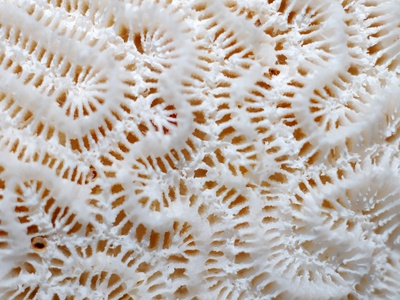
Brain Coral
Named for its grooved, maze-like appearance resembling a brain, this massive, slow-growing coral is a key reef-builder. The entire colony consists of genetically identical polyps living together.
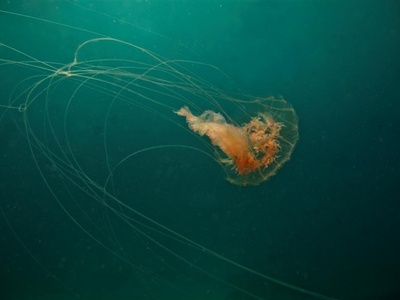
Box Jellyfish
Considered one of the most venomous creatures in the world. Its nearly transparent cube-shaped bell is followed by up to 60 tentacles, each loaded with stinging cells that can cause excruciating pain and death.
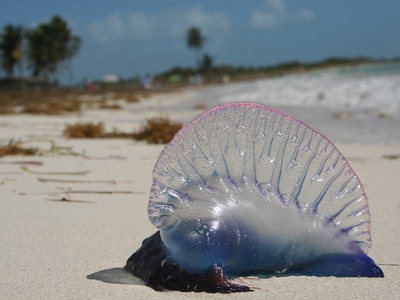
Portuguese Man o’ War
Often mistaken for a jellyfish, it’s a siphonophore—a colony of specialized organisms. Its gas-filled float sits above the water, while long, venomous tentacles trail below, delivering a painful sting.
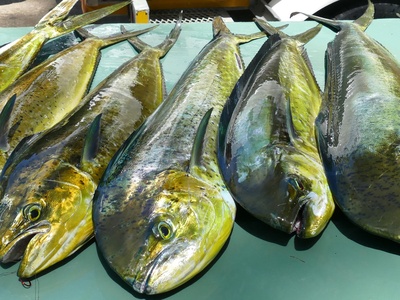
Mahi-mahi
Also known as dolphinfish, this fast-swimming predator is famous for its vibrant, iridescent colors that fade rapidly after death. It is a popular sport fish found in offshore waters, often near floating objects.
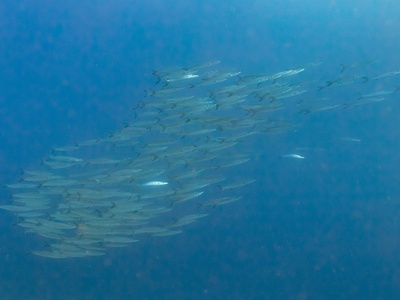
Great Barracuda
A fearsome-looking predator with a long, streamlined body and a mouthful of dagger-like teeth. It relies on short bursts of speed to ambush its prey, which includes a wide variety of fish.
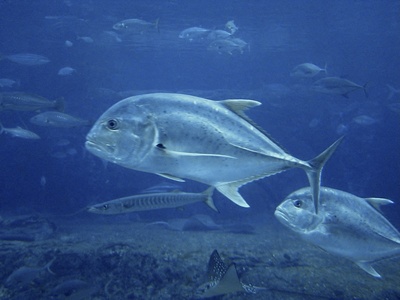
Giant Trevally
A powerful apex predator known for its aggressive hunting style and immense strength. It hunts fish, crustaceans, and even birds, often patrolling reef drop-offs. It is a prized catch for sport fishermen.
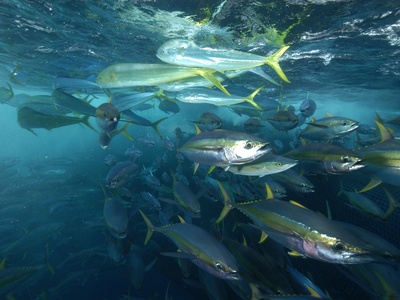
Yellowfin Tuna
A large, fast-swimming tuna species recognized by its bright yellow dorsal and anal fins. They are a highly migratory species, traveling in schools, and are one of the most commercially important fish in the world.
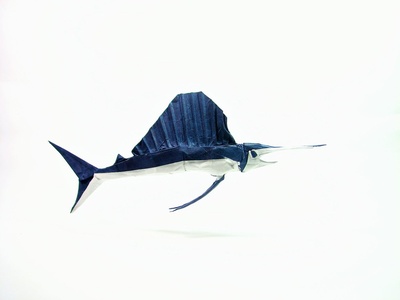
Sailfish
The fastest fish in the ocean, capable of reaching speeds over 100 km/h. It is renowned for its enormous, sail-like dorsal fin and long bill, which it uses to stun schooling fish like sardines.
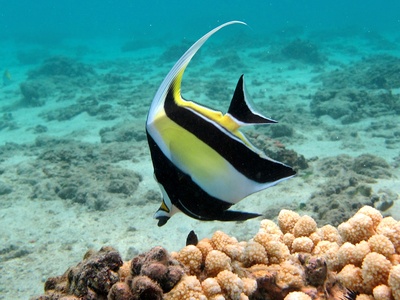
Moorish Idol
An iconic reef fish with a compressed, disk-like body and dramatic black, white, and yellow bands. Despite its resemblance to butterflyfish, it is the sole species in its family and is notoriously difficult to keep in aquaria.
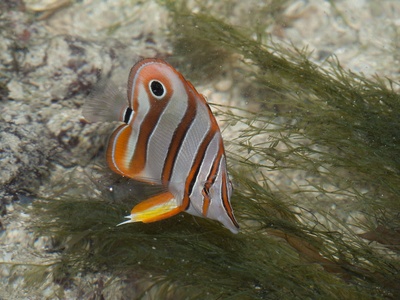
Copperband Butterflyfish
An elegant fish with a long, narrow snout used to pick out small crustaceans and worms from tight crevices. Its silvery body is marked with vertical copper-colored bands and a false eyespot near its tail to confuse predators.
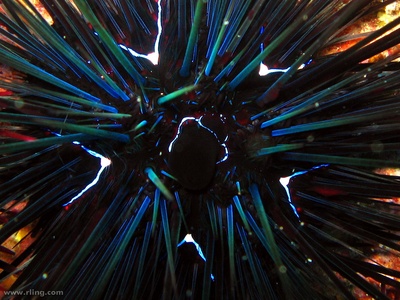
Long-spined Sea Urchin
This herbivore plays a crucial role in controlling algae on coral reefs. Its long, sharp, brittle spines provide excellent defense but can inflict a painful wound if touched. A mass die-off of this species severely damaged Caribbean reefs.
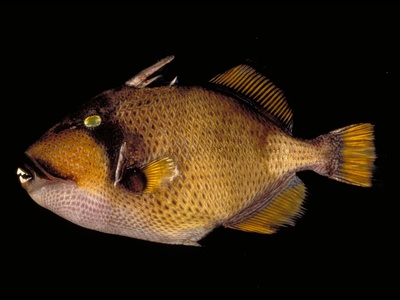
Titan Triggerfish
The largest triggerfish species, known for its aggressive and territorial behavior, especially when guarding its nest. It uses its powerful teeth to crush corals, crustaceans, and sea urchins.
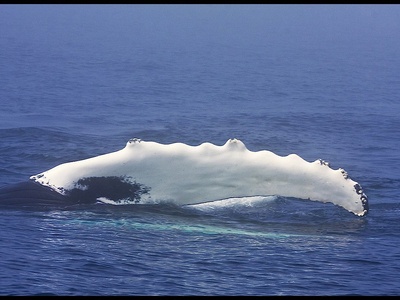
Humpback Whale
Famous for its spectacular breaching behavior and complex songs. These baleen whales migrate from polar feeding grounds to tropical waters to breed and give birth, making them a common sight for whale watchers.
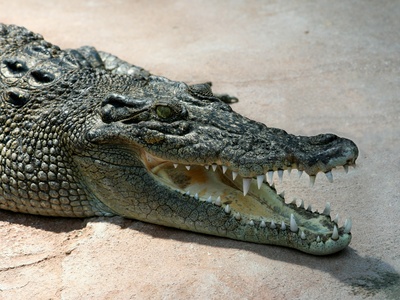
Saltwater Crocodile
The largest living reptile, this powerful apex predator can be found in both saltwater and freshwater habitats. It is an opportunistic hunter, capable of taking down prey as large as water buffalo.
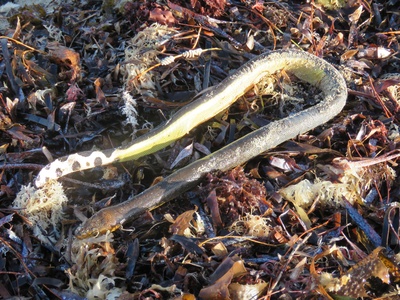
Yellow-bellied Sea Snake
The most widely distributed snake in the world, this highly venomous reptile spends its entire life in the open ocean. Its flattened, paddle-like tail helps it swim, and it feeds on small fish near the surface.
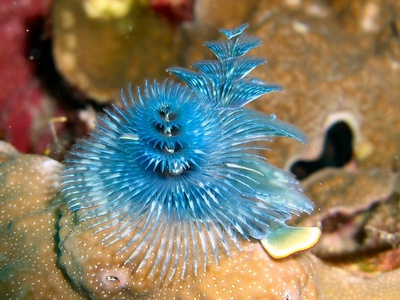
Christmas Tree Worm
These small worms live in tubes bored into live coral. They extend two brightly colored, spiral-shaped crowns for feeding and respiration, which look like miniature Christmas trees. They retract instantly when disturbed.
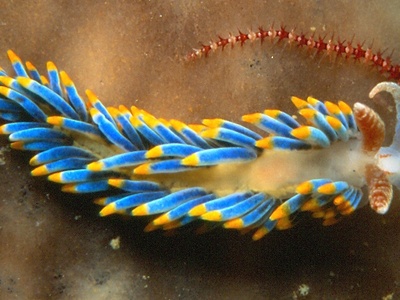
Nudibranch
A type of sea slug known for its stunningly vibrant colors, which serve as a warning to predators of its toxicity. Nudibranchs get their toxins from the sponges and hydroids they prey upon.
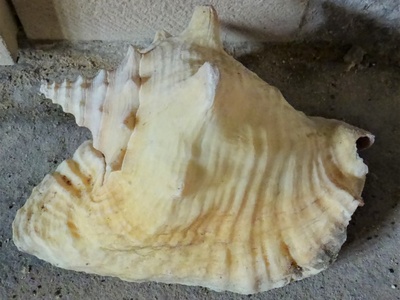
Queen Conch
A large sea snail with a beautiful, flaring pink shell that is an icon of the Caribbean. This herbivore uses its muscular foot to “hop” along the seafloor and is a culturally and economically important species.
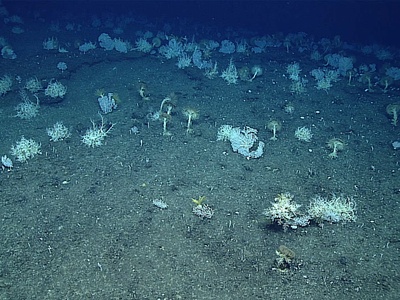
Feather Star
A free-swimming crinoid that uses its many feathery arms to filter plankton from the water. They can be seen perched on coral or “walking” along the reef. Their vibrant colors provide excellent camouflage.
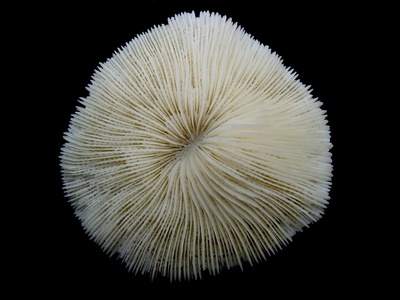
Mushroom Coral
Unlike most corals, this is a single, solitary polyp that is not attached to the seafloor. It is disc-shaped and can move short distances. It is surprisingly resilient and can recover from significant damage.
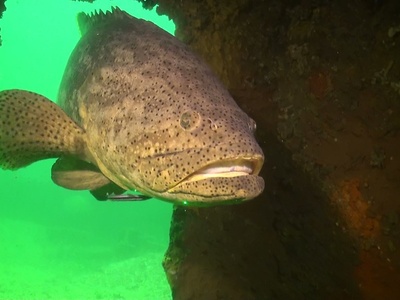
Goliath Grouper
An enormous fish that can weigh over 360 kg. These slow-moving, curious giants are critically endangered due to overfishing. They are known to congregate in large numbers at specific sites to spawn.
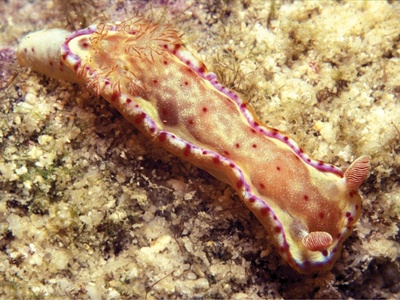
Spanish Dancer
One of the largest nudibranchs in the world. When disturbed, it can swim by undulating its body in a graceful, flamenco-like motion. It lays its eggs in beautiful, rose-like ribbons.
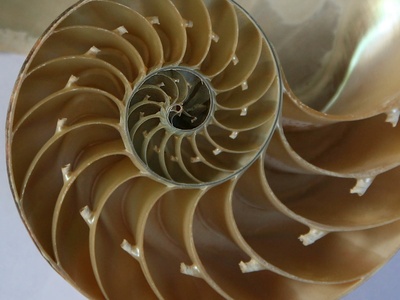
Chambered Nautilus
A “living fossil,” this cephalopod has changed very little in millions of years. It lives in a multi-chambered shell, adjusting its buoyancy by controlling the gas and fluid in the chambers, allowing it to move up and down.
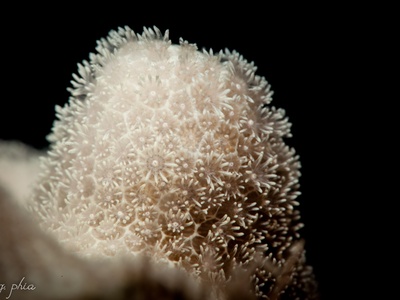
Finger Coral
This coral forms dense thickets with short, finger-like branches. It is a relatively hardy species and provides important structural habitat for small fish and invertebrates on shallow reef flats.
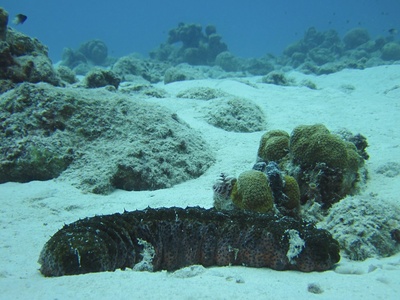
Sea Cucumber
A sausage-shaped echinoderm that plays a vital role as a “vacuum cleaner” of the seafloor, ingesting sediment and recycling nutrients. When threatened, some species can eject their internal organs.
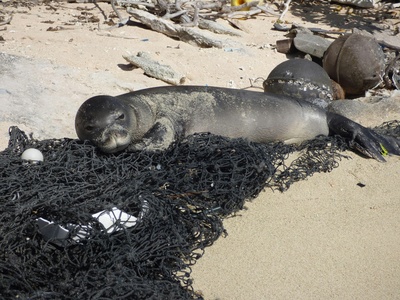
Hawaiian Monk Seal
One of the most endangered marine mammals in the world, this earless seal is endemic to the Hawaiian Islands. It spends much of its time at sea but comes ashore to rest and give birth on remote sandy beaches.
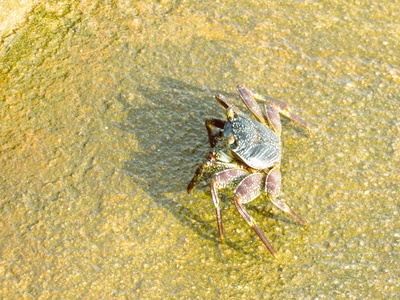
Arrow Crab
Identified by its long, spindly legs and triangular body, this small crab looks like a spider. It is a scavenger that perches on corals and sponges, waiting to pick off passing worms and other small invertebrates.
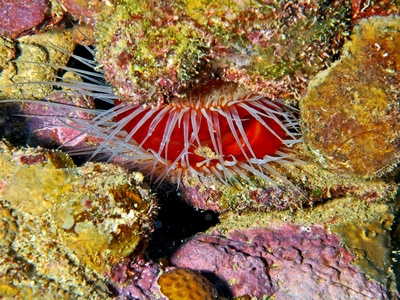
Flame Scallop
A bivalve with a bright red mantle and long sensory tentacles. It appears to have an electric “light show” running along its edge, but this is a reflection of light, not bioluminescence. It does not travel far from its crevice.
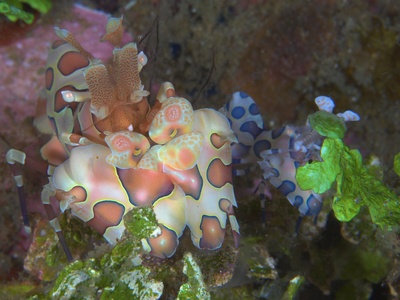
Harlequin Shrimp
A stunningly ornate shrimp that feeds almost exclusively on starfish. Working in pairs, they use their small claws to flip the starfish over and consume its tube feet, immobilizing it before eating the rest.
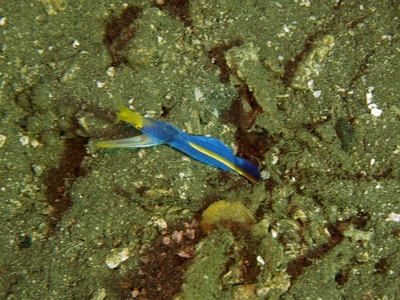
Ribbon Eel
A species of moray eel with a long, thin body and elaborate nostrils. They undergo dramatic color changes with age and sex: juveniles are black, adult males are electric blue, and females are yellow.
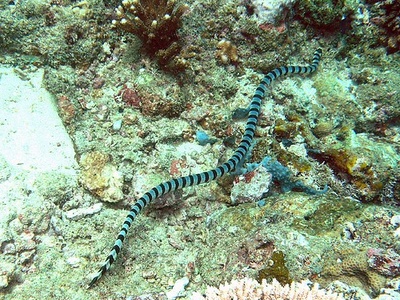
Banded Sea Krait
An amphibious sea snake with distinct black bands, a paddle-like tail for swimming, and ventral scales for moving on land. It hunts in the water but comes ashore to rest, digest, and lay eggs.
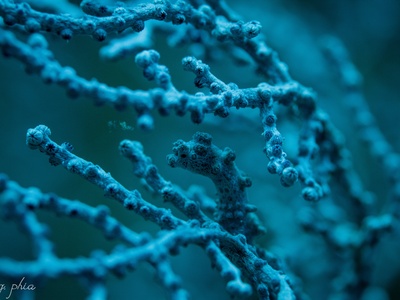
Pygmy Seahorse
One of the smallest seahorses in the world, this tiny creature is a master of camouflage. Its body is covered in tubercles that perfectly match the color and texture of the gorgonian coral it exclusively lives on.
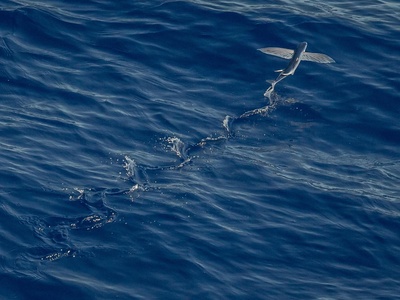
Flying Fish
This fish doesn’t truly fly but uses its powerful tail to propel itself out of the water and its large, wing-like pectoral fins to glide for long distances to escape predators like tuna and mahi-mahi.
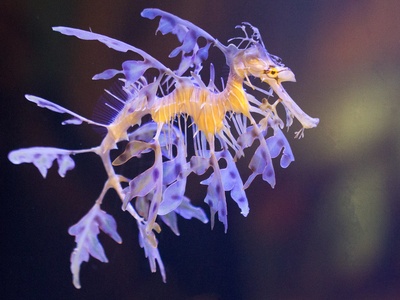
Leafy Seadragon
Though not strictly tropical, its unique form merits mention. An ornate relative of the seahorse, it has leaf-like appendages all over its body, providing perfect camouflage among seaweed and kelp.
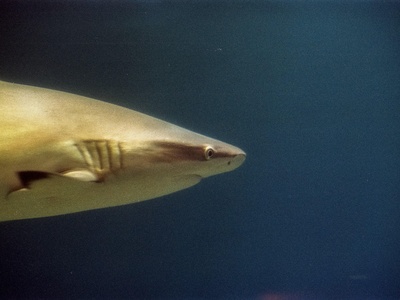
Horn Shark
A small, bottom-dwelling shark with a blunt head and prominent ridges over its eyes. It is a nocturnal hunter that uses its specialized teeth to crush the shells of crabs, sea urchins, and snails.
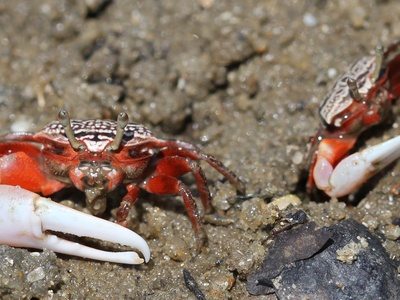
Fiddler Crab
Recognizable by the male’s single, oversized claw, which is used in courtship displays and to fight other males. They are crucial to mangrove ecosystems, aerating the sediment as they burrow.
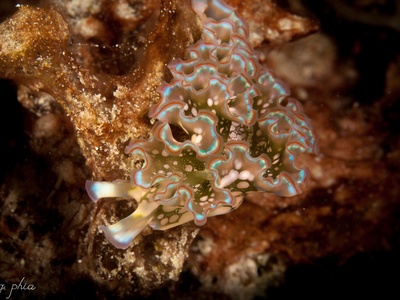
Lettuce Sea Slug
A beautiful, frilly sea slug that can photosynthesize. It incorporates chloroplasts from the algae it eats into its own tissues, allowing it to generate energy from sunlight like a plant.
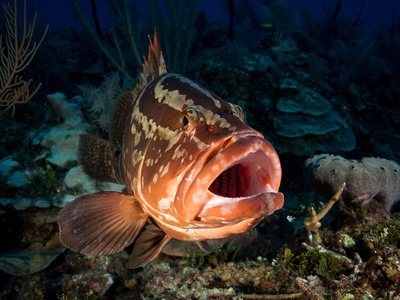
Nassau Grouper
An iconic, large-bodied fish known for its ability to change color patterns. It is critically endangered due to overfishing, particularly at its large spawning aggregations, which are now protected.
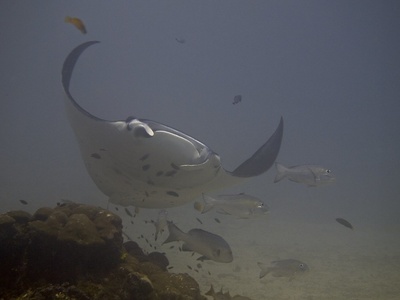
Reef Manta Ray
Slightly smaller than its giant relative, the reef manta is more commonly found in coastal areas. These intelligent animals have unique spot patterns on their undersides that can be used to identify individuals.
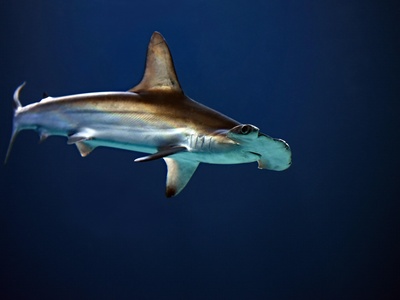
Scalloped Hammerhead Shark
Distinguished by the “scalloped” front edge of its wide head. Unlike most sharks, they are often social, forming large schools of up to several hundred individuals, a behavior that is still not fully understood.
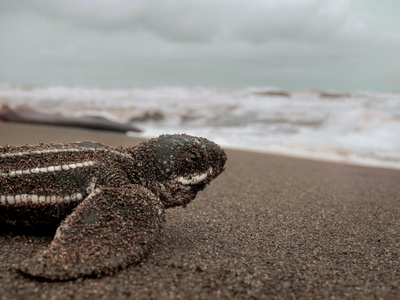
Leatherback Sea Turtle
The largest turtle on Earth, it lacks a hard, bony shell. Instead, its back is covered by a leathery, oil-saturated skin. It is a deep-diving specialist that feeds almost exclusively on jellyfish.

Olive Ridley Sea Turtle
The most abundant sea turtle, famous for its synchronized mass nesting events called “arribadas,” where thousands of females come ashore at the same time to lay their eggs on a single beach.
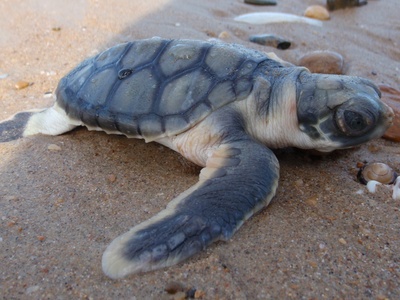
Flatback Sea Turtle
Named for its relatively flat shell, this turtle is unique as it only nests on Australian beaches. Its eggs and hatchlings are larger than those of other species, potentially offering better protection against predators.
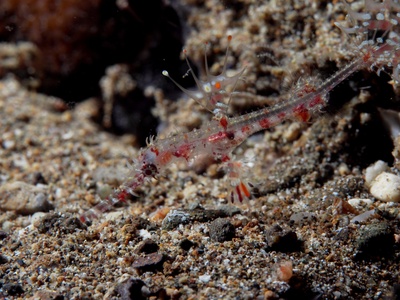
Ornate Ghost Pipefish
A small, bizarre-looking fish that is a master of camouflage, mimicking floating seaweed or crinoid arms. The female carries the eggs in a special brood pouch formed by her pelvic fins until they hatch.
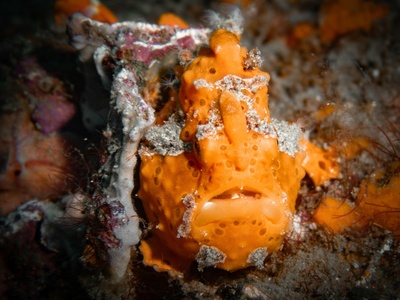
Frogfish
A strange, lumpy ambush predator that can change its color to perfectly match its surroundings. It has a modified dorsal spine that it uses as a “lure” to attract small fish close to its enormous mouth.
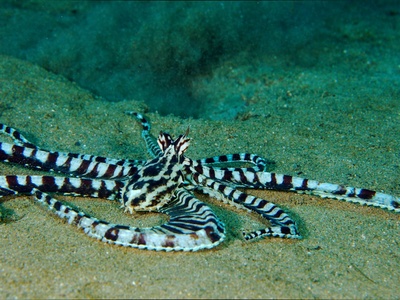
Mimic Octopus
This incredibly intelligent octopus can impersonate other sea creatures like lionfish, sea snakes, and flatfish by changing its color, texture, and body shape to deter predators or stalk prey.
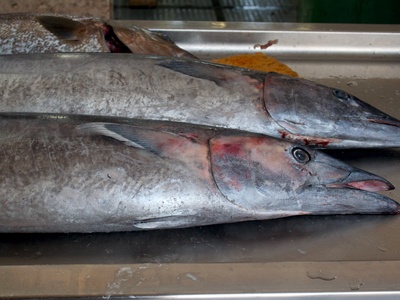
Wahoo
A long, slender predator renowned for its incredible speed, making it a prized game fish. Its razor-sharp teeth and powerful jaws allow it to feed on other fast-swimming fish like tuna and mackerel.
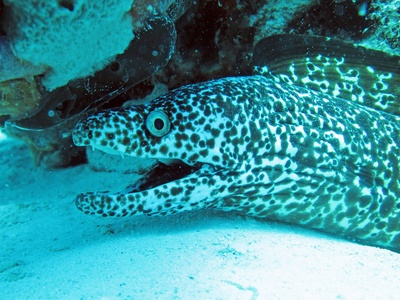
Spotted Moray Eel
A common moray eel with a pale body covered in dark spots. Like other morays, it has a second set of jaws in its throat, called pharyngeal jaws, that shoot forward to help grasp and swallow prey.
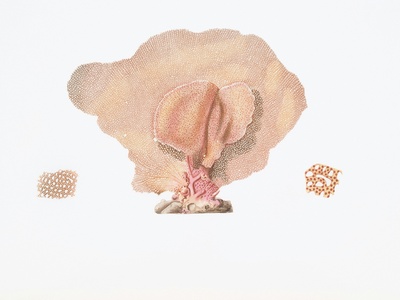
Gorgonian Coral
Also known as a sea fan, this is a soft coral that grows in a flat, fan-like shape. It orients itself perpendicular to the current to maximize its ability to filter-feed on plankton.
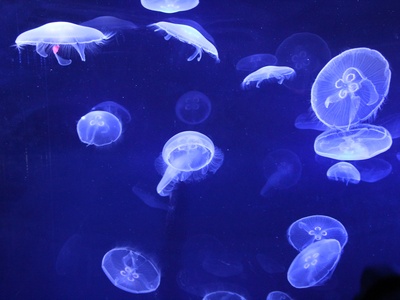
Moon Jellyfish
A common, translucent jellyfish recognized by the four pink or purple horseshoe-shaped gonads visible through its bell. Its sting is mild and generally harmless to humans.
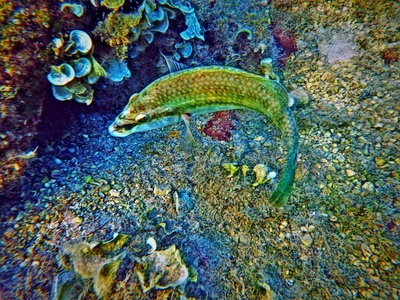
Thorny Seahorse
This seahorse is covered in sharp spines, providing excellent defense and camouflage among spiny corals and seaweed. Like all seahorses, the male carries the developing young in a brood pouch.
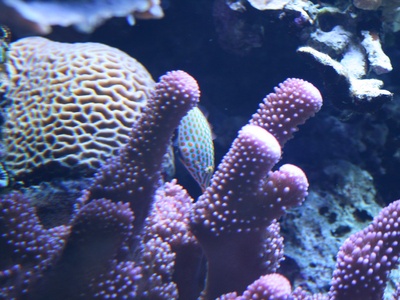
Harlequin Filefish
A beautifully patterned fish that feeds solely on the polyps of Acropora coral. Its coloration provides perfect camouflage among the coral branches where it lives and nests.
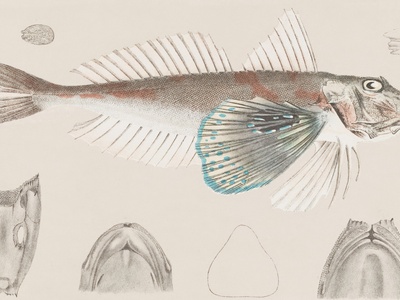
Longnose Hawkfish
A small, distinctive fish with a red and white grid pattern and an elongated snout. It often perches on the branches of sea fans or corals, waiting to dart out and catch small crustaceans.
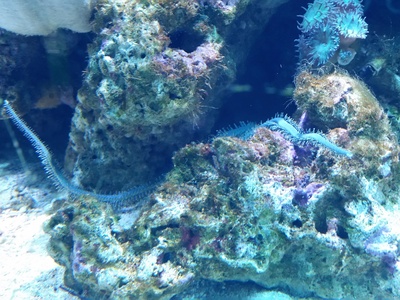
Bobbit Worm
A terrifying ambush predator that buries its long body in the seafloor, leaving only its powerful, iridescent jaws exposed. It strikes with incredible speed, sometimes slicing its prey in half.

Banded Coral Shrimp
A striking shrimp with red and white bands and long white antennae. It is a known cleaner species, often found in pairs, that signals its services to passing fish by waving its antennae.
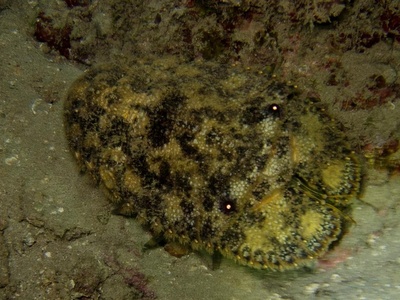
Slipper Lobster
A clawless lobster with flattened, shovel-like antennae. It is a nocturnal bottom-dweller that uses its powerful tail to escape predators. It is a close relative of the spiny lobster.
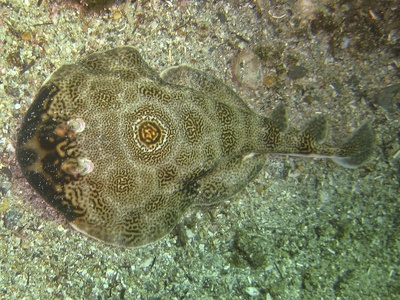
Electric Ray
This ray can generate a powerful electric shock of up to 220 volts to stun prey and defend itself. It is a sluggish, nocturnal predator that lies buried in the sand waiting for unsuspecting fish.
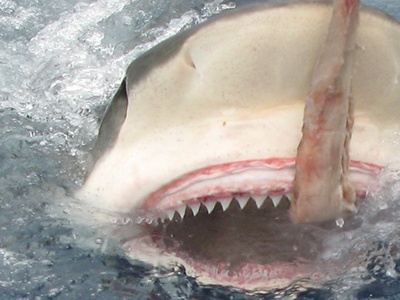
Tiger Shark
A large, macropredator known for its indiscriminate diet, earning it the nickname “wastebasket of the sea.” Young sharks have dark stripes that fade with age. It is considered one of the most dangerous shark species.
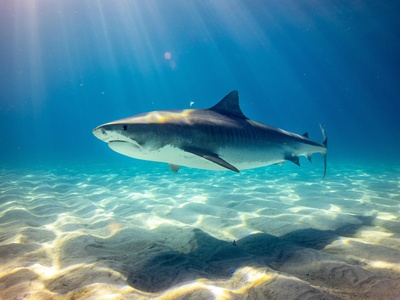
Bull Shark
A robust, aggressive shark known for its ability to tolerate freshwater, allowing it to travel far up rivers. This behavior, combined with its preference for shallow coastal waters, brings it into frequent contact with humans.
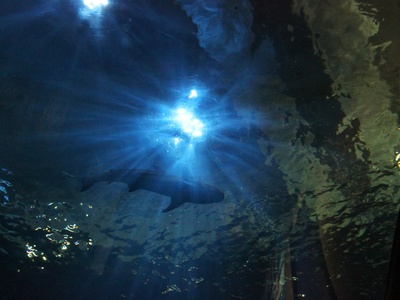
Sandbar Shark
Characterized by its very tall first dorsal fin, this is one of the largest coastal sharks. They are bottom-feeding sharks that primarily eat fish, rays, and crabs, and often migrate along coastlines.
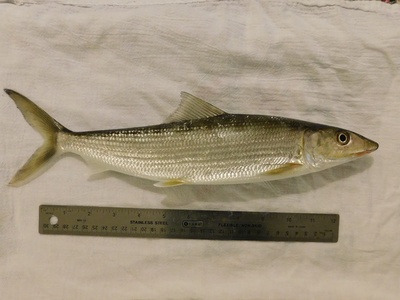
Bonefish
A prized game fish known for its incredible speed and power when hooked. It feeds in very shallow coastal waters and sand flats, using its conical snout to root out crustaceans and worms from the sediment.
